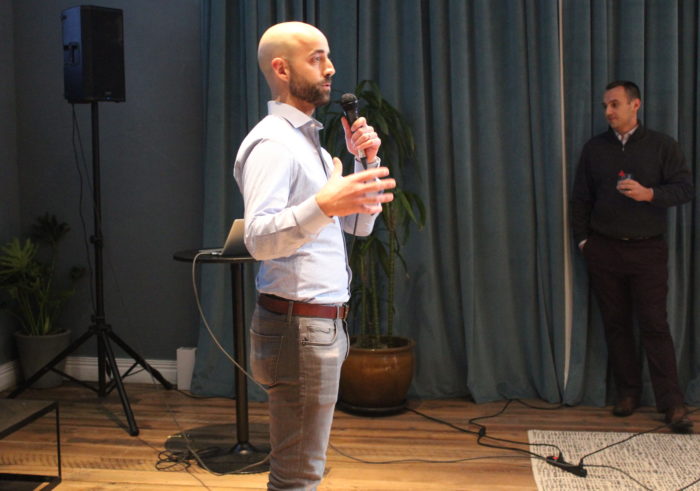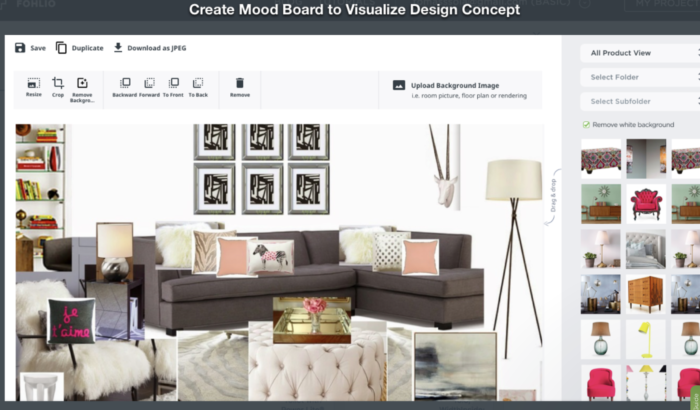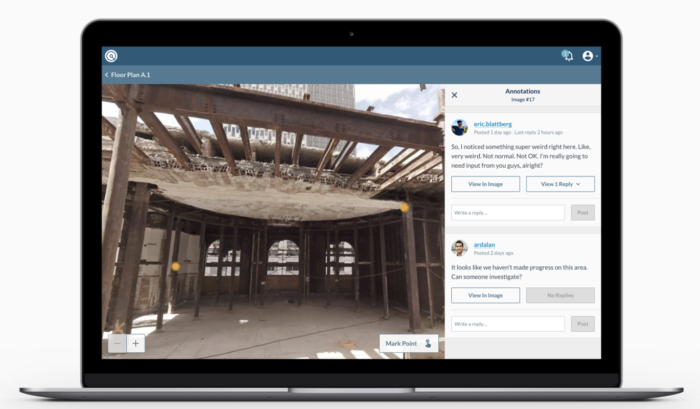When Tech Meets Real Estate, Construction Gets Smarter
Five startups show how their digital inventions can help development go faster and more efficiently
Fentrend helped a developer find the right windows for this new building on Grand Street in Brooklyn (Image courtesy of Fentrend)
Pulling all the pieces together in a construction project is a herculean task with high stakes. When it’s not done right, it can cost time, money and even lives. Technology to the rescue! That was the theme of the RE | Tech Demo last week at Brooklyn’s Williamsburg Hotel, where five young companies showed how they’re changing the architecture, engineering and construction industries.
Reps for the five startup companies described how they’re leveraging tech to get projects launched, find eco-friendly components like windows and doors, organize the elements of interior design, create digital models of a building’s surroundings, and keep a close eye on construction sites. Hosting the demo was Totem, a Brooklyn firm specializing in place-making, real-estate development and technology, in partnership with the design firm WXY and CREtech. The gist of the five presentations:

Mike Pettinella of BuildingConnected talked about how his company helps organize the pre-construction aspects of development projects (Photo by Arden Phillips)
Getting off on the Right Foot
Founded in San Francisco in 2012, BuildingConnected has designed a digital platform to make the pre-production phase of building construction more seamless. Founders Dustin DeVan and Jesse Pedersen set out to develop a program that would connect the many parties involved in a project and coordinate such tasks as managing bids and monitoring progress. Mike Pettinella, a vice president of BuildingConnected, described pre-construction as a delicate phase of real-estate development and where BuildingConnected puts its focus.
“It’s a solution that’s helping owners, general contractors and subcontractors collaborate more effectively during, in my opinion, the most sensitive phase of a project, which is before any shovel hits the ground and before anything actually happens, when it’s conceptual,” Pettinella said. That is “when you need to get the effective pricing, when you need to get the specs, the drawings, and everything to collaborate during that phase in order to prepare and evaluate the proposals that you’re receiving.”
Better Windows, Lower Costs
“I get a lot of eye rolls when I tell people that I’m in the window and door industry, for some reason. I get it. It’s a very niche market,” said Andy Huh, CEO and co-founder of Fentrend, a service designed to match architects and contractors with the best eco-friendly doors and windows for their projects. But he emphasized its long-term importance. “This market is way more complex and way more impactful than you think,” showing a slide to graphically show energy waste. “We took this thermal image in Brooklyn about five years ago and what it illustrated essentially is heat escaping from buildings in New York City. This is how inefficient most buildings are in New York,” he said.
“And not only in New York, but in the U.S,” he added, where energy generation for buildings accounts for 40% of greenhouse-gas emissions, Huh said. “So while Elon Musk is addressing the transportation and automobile market, the big market is actually addressing the building market. Because your envelope, your insulation–depending on what sort of windows and doors you specify on your project–this impacts the heating and cooling loads of the building. It’s a complex category.” Fentrend, which Huh launched with three partners, was one of two winners of the 2016 Urban Future Competition at the NYU Tandon School of Engineering.

A sample of a Fohlio digital mood board, which helps designers to envision new interiors (Image courtesy of Fohlio)
Getting a Picture of a Place
Fohlio, founded in 2015, is a database designed to share construction products, finishes and specifications, which can be assembled on visual mood boards. “Our general idea is this: The tech industry has become really good at organizing a lot of public data. Being able to tell you, ‘You want these weightlifting shoes,’ or whatever it is. But we don’t have that kind of precision when it comes to building and private data,” said Matt Abedi, Fohlio’s director of architect and interior design outreach.
“So our idea there is to make sure that all of the details behind a building are not only accessible and searchable, but can be passed back and forth with ease,” he said.
“So if you produce a spec book and hand it over to a contractor and the contractor needs to hand that back to you and let you know about some changes, you don’t have to worry about a phone call or a missed notepad or a sticky note.”

Geopipe helps developers imagine their prospective buildings in the real world (Image courtesy of Geopipe)
Digital Models of the World
Founded by Christopher Mitchell and Thomas Dickerson, Geopipe is a digital platform that creates realistic virtual worlds for industries including real estate, urban planning and architecture. Geopipe was born out of the need to put the real world into a virtual space, much as video games do. “I was trying to create the five boroughs of New York City in the game Minecraft so that I could build my own buildings in New York City,” said Mitchell. “And my co-founder loves Lego. [He] looked at the Lego architecture sets and thought, ‘How can I teach a computer to create Lego architecture sets out of giant, full-scale buildings automatically?’ And through working on these projects, we found that there was a bigger problem. You couldn’t actually get rich, interactive 3D models of the real world. That inspired us to found Geopipe. We build software that automatically creates rich models of the real world that you can import into your own software.”

A sample of the interface of OnSiteIQ, which helps developers keep track of job sites (Image courtesy of OnSiteIQ)
They Bring the Site to You
OnSiteIQ is designed to help all the parties involved in a construction project keep track of its progress in minute detail. “As you might know, three workers a day die on construction sites here in the United States. The sad reality is that more than 90% of these fatalities and injuries would be preventable if only people followed the rules. If you dig a little bit deeper, you’ll notice that there’s a very strong correlation between the frequency of inspection on construction projects and the number of injuries and fatalities,” said co-founder Ardalan Khosrowpour.
OnSiteIQ collects data from a specific site twice a month, inspects the site for safety and quality, and then shares the findings with the construction team. “We work with owners, developers, insurance companies, and construction managers. We have a network of independent data collectors who go to the job sites every week. They walk the site and scan the entire site,” Khosrowpour added. The AI platform that the company uses then goes through the data and identifies the different safety issues and hazards.
At the conclusion of the demo, Adam Lubinsky, one of the managing principals at WXY, recalled working on the development of the Brooklyn Tech Triangle strategic plan a few years ago and marveled at the borough’s progress in becoming a technology hub. “To see what has happened and the kind of energy that is happening here in Brooklyn–and the kind of work that’s coming out of companies such as the ones that we saw tonight–it’s totally inspiring and totally amazing,” he said.













